by Sheila Dunning | Mar 1, 2017
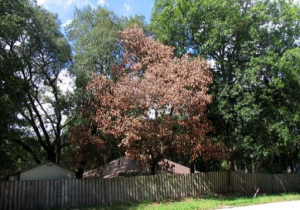
Swamp Redbay Tree infected with Laurel Wilt. Photo credit: Sheila Dunning
Many invasive plants and insects are introduced in packing materials, including 12 species of ambrosia beetles, which embed themselves in wood used as crates and pallets. While these tiny beetles don’t actually feed on wood, the adults and larvae feed on fungi that is inoculated into galleries within the sapwood by the females when they deposited their eggs. While the ambrosia fungus keeps the beetles alive, it kills the host tree. This is the projected fate of redbay trees (Persea borbonia) due to the Redbay Ambrosia Beetle.
First detected in the United States in a Georgia trap in 2002, Xyleborus glabratus, the Redbay Ambrosia Beetle, caused substantial mortality of redbay in northern Duval County, Florida in 2005. This ambrosia beetle introduces fungal spores, (Raffaelea lauricola) from specialized structures found at the base of their mandibles into the vascular system of plants when boring into host trees of the Lauraceae family. This insect and disease complex has collectively been named “Laurel Wilt.” Infected redbays, assafrass and avocado trees wilt and die within a few weeks or months.
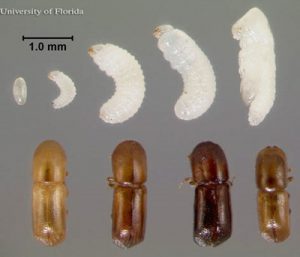
Ambrosia Beetle life stages
The Redbay Ambrosia Beetle is a shiny black, cylindrical insect about 2 mm in length. The males are flightless and the females can only fly short distances (1 – 1.5 miles). Therefore, host trees are often attacked many times and stands of redbays are damaged quickly. Small strings of compacted sawdust may protrude from the bark at the point of initial attack. However, wind and rain easily remove this sign leaving the only symptom to be the total browning of foliage in a section of the tree’s crown. Since the fungus blocks the xylem (water-carrying) tissue of the redbay, it appears to wilt while leaves remain attached. Once infected, the trees cannot be saved.
To avoid spreading the beetle and pathogen to new areas, the trees need to be cut down and wood or chips from the infested trees should not be transported off site. Where allowed, the materials should be burned on site. Protection of unaffected trees is possible with expensive pesticides if applied in a timely manner and using the correct techniques. Removal of all susceptible tree species is not recommended. The survivors may hold a genetic tolerance.
by Carrie Stevenson | Mar 1, 2017
Special Guest Blogger – Lorraine Ketzler, Biological Science Technician with US Fish and Wildlife Service
There have been several fungal invaders entering and spreading within the US in recent years and I’d like to draw attention to four of them:
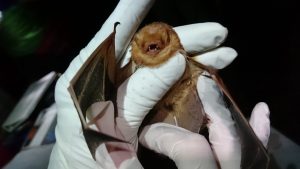
Eastern red bats being surveyed for White-nose Syndrome at Talladega National Forest, AL. Photo credit: Lorraine Ketzler
- White-nose Syndrome (WNS) in bats (Pseudogymnoascus destructans)
- Chytridiomycosis (Chytrids) in frogs (Batrachochytrium dendrobatidis)
- Chytridiomycosis (B-sal) in salamanders (Batrachochytrium salamandrivorans)
- Laurel wilt disease (Raffaelea lauricola) in Lauracea family trees (redbay, sassafras, avocado and others), transferred by the invasive redbay ambrosia beetle (Xyleborus glabratus).
These diseases have devastating effects on multiple species. Bats, frogs, and salamanders are important insect predators, and all species –including trees- cycle nutrients through ecosystems to provide carbon storage benefits as well as other services. Bat populations in North America are declining precipitously as WNS marches westward across the continent. Many frog populations across the globe have disappeared because of Chytrids, with several species recorded as extinct and some are being listed under the Endangered Species Act. In addition to nutrient cycling, Lauracea trees benefit humans as food crops, aromatic ornamental trees, and medicinal plants. However, Laurel wilt disease is found in nearly every county in Florida, and continues to spread throughout the southeast.
The state and the US must remain vigilant and monitor against the introduction of B-sal, a recently discovered and highly transmissible disease spread through pet trade salamanders. It has not yet been observed in the US, but has caused widespread declines in native salamanders of the Netherlands and UK.
Unprecedented numbers of new and emerging pathogenic fungi continue to be discovered. Fungi genomes are amazingly adaptable, overcoming plant and animal defenses, and becoming resistant to fungicides. Increasing human traffic, trade, and disturbance introduce these pathogens to new habitats. Trade ports are key introduction sites. Always practice decontamination procedures when handling wildlife and native plants, even in areas without confirmed infections to prevent the spread of disease to new populations.
Help Stop the Spread of Non-native Species
by Jennifer Bearden | Feb 27, 2017
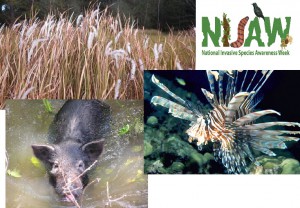 Aliens are invading our forests, pastures, fields and lawns. Well, okay, not aliens but invasive species are invading our beautiful landscapes. Invasive species are non-native or exotic species that do not naturally occur in an area, cause economic or environmental harm, or negatively impact human health. These invasive species have become the number one threat to biodiversity on protected lands. However, invasive species do not know boundaries, and as a result, public, private lands, natural and man-made water bodies, and associated watersheds are affected. National Invasive Species Awareness Week (NISAW) is February 27-March 3, 2017.
Aliens are invading our forests, pastures, fields and lawns. Well, okay, not aliens but invasive species are invading our beautiful landscapes. Invasive species are non-native or exotic species that do not naturally occur in an area, cause economic or environmental harm, or negatively impact human health. These invasive species have become the number one threat to biodiversity on protected lands. However, invasive species do not know boundaries, and as a result, public, private lands, natural and man-made water bodies, and associated watersheds are affected. National Invasive Species Awareness Week (NISAW) is February 27-March 3, 2017.
It is estimated that Florida Agriculture loses $179 million annually from invasive pests (http://www.defenders.org/sites/default/files/publications/florida.pdf). Generally, eradication of an invasive species is difficult and expensive. Most of the mitigation efforts focus on control rather than eradication.
EDDMaps (Early Detection and Distribution Mapping System), a web-based mapping system for reporting invasive species, currently has 667 different invasive plants reported in Florida. Many invasive insects, animals and diseases have also landed in Florida. Some famous invasive species in Florida include cogongrass, wild hogs, red imported fire ants, Chinese tallow, and lionfish.
For National Invasive Species Awareness Week, the University of Florida IFAS Northwest Extension District will highlight new invasive species each day. There are a couple of ways to receive this information during NISAW:
You can help us control invasive species in several ways. First, always be cautious when bringing plants or plant materials into the state. Plants or even dead plant material can harbor weeds, insects and diseases that can become invasive in our state. Second, when you see something suspicious, contact your local extension agent for help identifying the weed, insect or disease. Third, you can volunteer your time and effort. Invasive species control is difficult and requires a cooperative effort for funding and manpower. The state has several Cooperative Invasive Species Management Areas (CISMA) in which public and private organizations work together to control invasive species in their area. These CISMAs hold work days in which volunteers can help remove invasive species from the environment.
For more information about NISAW or invasive species, contact your local county extension agent.
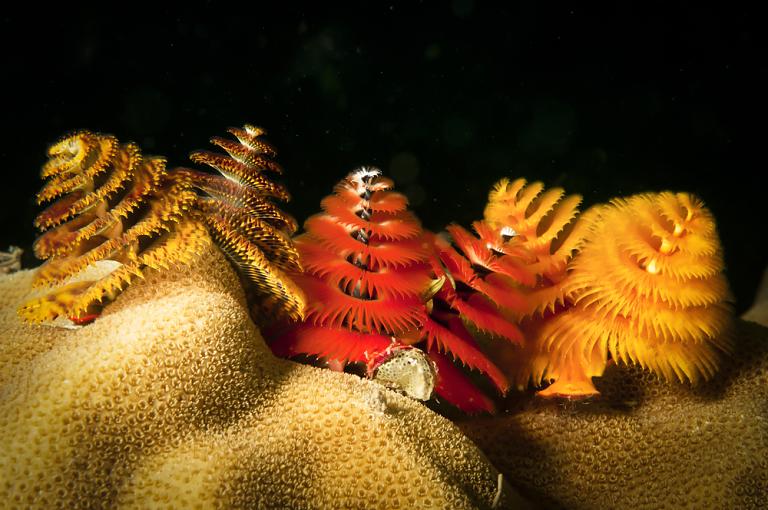
by Chris Verlinde | Dec 19, 2016
The holiday season is a special time for most of us! There are many creatures that live under the sea that represent many of our holiday traditions.
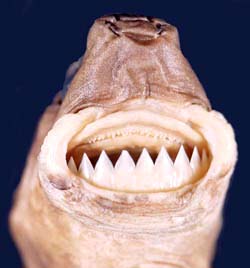
Photo Credit: Fl. Museum Of Natural History, George Burgess
Small cookie cutter sharks are found in very deep water during the day, at night they migrate up the water column to feed. Cookie cutter sharks attract their prey with lighted photophores. Photophores are lighted organs located on the lower part of the shark. Small fish are attached to the glow, larger fish searching for prey get close enough to the shark and the shark bites the prey. The cookie cutter shark has specialized sucking lips that attach to the victim. The shark then spins its body around and leaves a cookie cutter shaped hole in the fish.
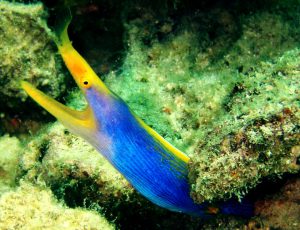
Photo credit: Wikimedia Commons
Ribbon Eels are found in the Indio Pacific. They have long slender bodies and move like ribbons in and through the crevices reefs. They eat live fish. To view a YouTube video of ribbon fish feeding, click here.
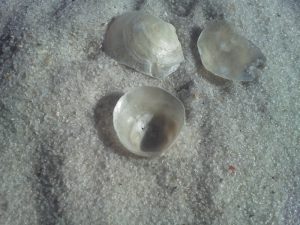
Photo credit: Chris Verlinde
Jingle shells get their name as a result of their shells that when shaken together make a jingle like sound. Jingle shells can be found along the beaches of NW Florida. The shiny iridescent shell is strong and very attractive. Many shell collectors use the shells to make jewelry and wind chimes.
Jingle shells are bivalves and live attached to hard surfaces, just like oysters.
Jingle shells are filter feeders, meaning water is filtered through their gills for plankton.
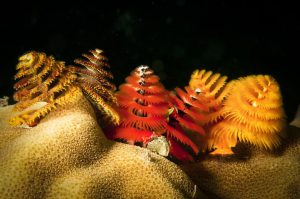
Photo credit: Wikimedia commons
Christmas tree worms are Christmas tree shaped worms that form burrows corals. The tentacles, which form the tree-like structures are used for feeding on plankton and to breathe. These plumed creatures are a type of polychaete worm.
Christmas tree worms come in many colors and can be found all over the world. They feed by using their feathery appendages, called radioles to capture phytoplankton that floats by the “feathers.”
Christmas tree worms are easily disturbed and will quickly vanish into their burrows as shadows or larger marine life pass by. They return quickly and continue with their sedimentary lifestyles in the coral.
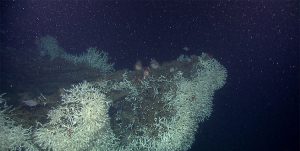
“Marine snow” falls gently on to a coral-covered shipwreck explored in the Gulf of Mexico in 2012 by the NOAA Ship Okeanos Explorer. Photo Credit NOAA
Marine snow gets its name as a result of the fluffy materials that resemble snow falling from the sky. Marine snow is decaying material from plants and animals that have died in the oceans. Marine snow may also include sand, fecal matter and inorganic dust.
Just like snowflakes, marine snow grows as it floats to the ocean depths. Marine snow is consumed by scavengers that live along the deep-sea floor bottom. Check out the video below showing the beauty of marine snow.
There are many more festive creatures that live in the sea. Have a wonderful Holiday Season!
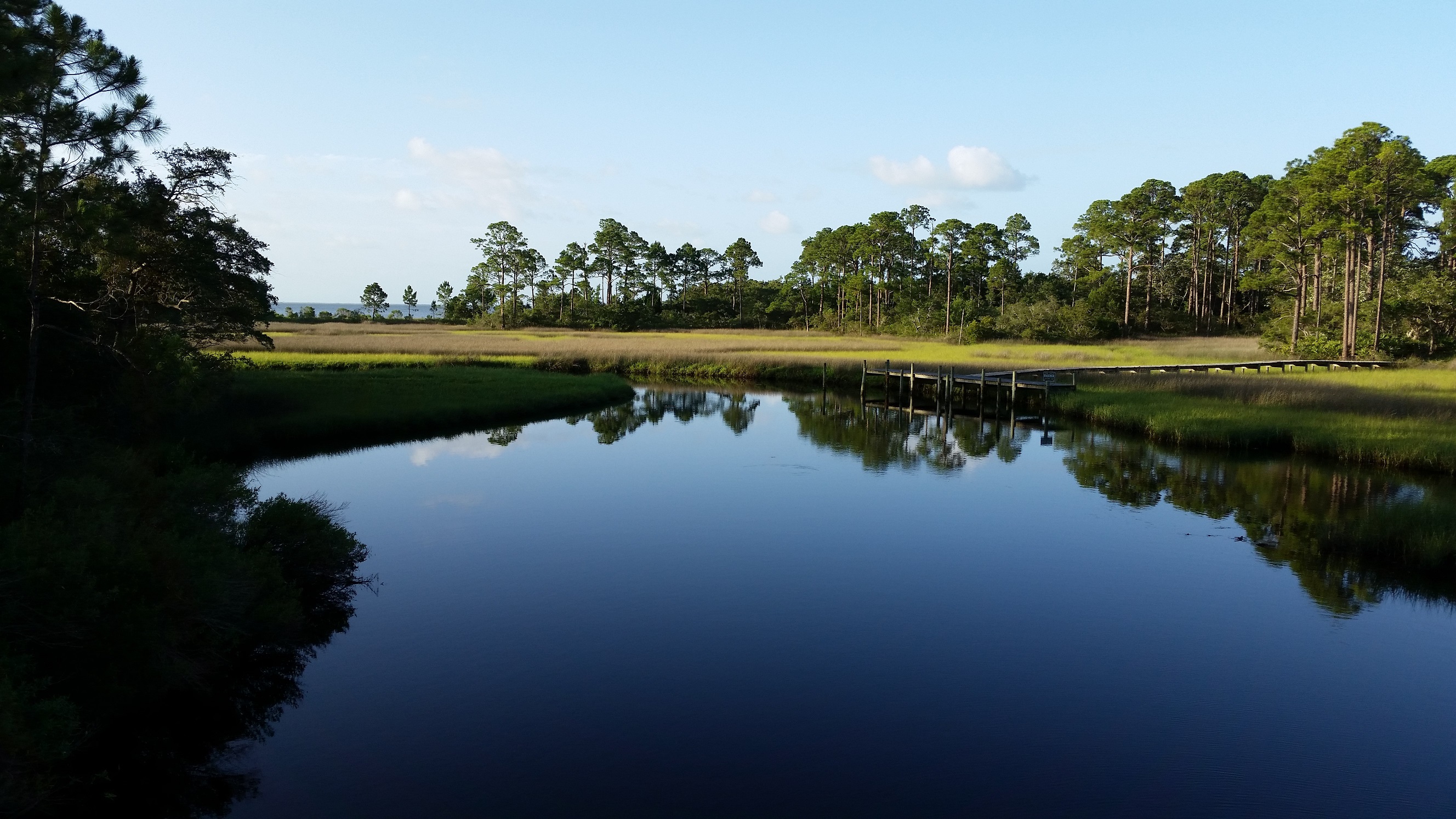
by Erik Lovestrand | Aug 13, 2016
The Florida Panhandle is fortunate to have an abundance of salt marsh habitat fringing many of our coastal environs. Although this habitat may not receive the appreciation it deserves by those seeking a white-sandy beach, it is intricately linked with many of the natural treasures we are blessed with. Salt marshes occur in the ecotone where the land connects with the salty water and they are occupied by a special assemblage of salt-tolerant, hydrophytic plants that provide benefits on many levels. Literally, levels that stretch vertically from the substrate to the tops of the grasses, and horizontally as the plant species are arranged into different zones depending on water depth. These habitats typically occur in coastal areas of lower wave energy, where the marsh plants can establish and thrive. Often this is in our bays and estuaries that are afforded some protection from storms that blow in from the open Gulf. Looking from the land outward, the classic salt marsh vegetation zones begin with the high-marsh which only gets inundated during extremely high tides. This area is dominated by a grass called marsh hay (or salt meadow) cordgrass (Spartina patens) that grows in wiry-leaved clumps. You can also find salt grass (Distichlis spicata) which has shorter, flat leaf blades that project from the stem at a distinctive angle. The mid-marsh zone is typically in and out of the water on daily tides and is usually dominated by a species of rush called black needlerush (Juncus roemerianus). The low-marsh grows in an area that stays under water much of the time and is inhabited primarily by smooth cordgrass (Spartina alterniflora) in our Gulf Coast marshes.
Ecologically speaking, you might deduce that salt marshes are not incredibly diverse, at least as far as plant species inhabiting them. However, the structure, cover and vegetative food components that are available here support a tremendous assortment of animals; some that we depend on for seafood, some that our seafood depends on in a complex food web, and others that are simply a pleasure to know about. Many utilize these grassy nearshore areas during the juvenile portion of their life cycle. Baby crabs, shrimp and fish find many of their needs met here. Just spend a few minutes quietly observing in this habitat and you’ll be amazed when you notice the baby mullet, spotted sea trout, redfish, killifish, fiddler crabs, and a host of other creatures going about their “marshy” business. It is also a special treat to conduct a nighttime investigation with a flashlight here. Just wear protective shoes as oysters often grow in these places.
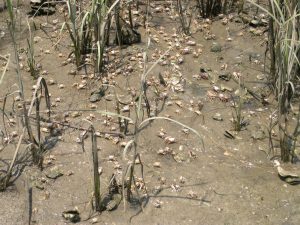
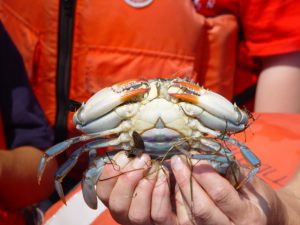
Blue Crabs and Fiddler Crabs Both Grow Up in the Marshy World
One group of animals that depends on this habitat is our coastal bird life. In fact, there is a subset of birds here that has been dubbed with the title “secretive marsh birds,” because they rarely come into the open where people can see them. This group includes several species of rails, bitterns, gallinules and others. Scientists have been concerned about declines in many of these species so standardized methods have been developed to survey them using broadcast recordings to elicit vocalizations that can be counted by researchers. There are also many not-so-secretive marsh birds that find their needs met in our marshes. Harriers visit during the winter months, blackbirds and sparrows find nesting cover here, and egrets, herons and kingfishers dine on the fish and invertebrates that are abundantly plentiful during key stages of their nesting and chick raising cycles.
Last but not least (in my book) are a couple of reptiles that can be found in our saltmarshes. The gulf salt marsh snake (Nerodia clarkii) uses the marsh for cover and to find its preferred diet of small fish, crabs, shrimp and other invertebrates. They spend their days generally hiding under debris, being more active at night. They can be recognized by their four lengthwise yellowish stripes and the fact that you aren’t likely to find another snake in the saltmarsh. However, I have seen a cottonmouth or two spending time here, so be careful. The other unique reptile we can find in select areas of our marshy coastline is the ornate diamondback terrapin (Malaclemys terrapin macrospilota). These charismatic coastal turtles are sexually dimorphic, with males only reaching about five inches and females growing to around eight inches. The yellow centers on the dark scutes of the back are a definitive identification feature, along with very pale gray skin that may be speckled with black dots. Terrapins feed primarily on mollusks and crabs and use the adjacent upland areas for laying their eggs. Terrapins have suffered dramatic declines throughout their range because they are attracted to bait in crab traps and can be trapped and drowned. There is a simple conservation solution though. If you are in an area that terrapins frequent you can install a rectangular exclusion device in your trap funnels that will keep out terrapins but let crabs through. Awesome invention!
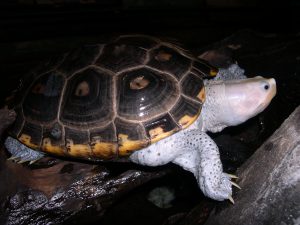
Ornate Diamondback Terrapins Depend on Coastal Marshes and Sea Grass Habitats
Take some time to visit our incredible coastal marshes and appreciate the diversity of life they provide us, along with the most profound serenity of any beautiful, wide-open vista that you’ll ever find anywhere.
by Ray Bodrey | May 13, 2016
The Annual Tupelo Honey Festival will be held on Saturday, May 21st from 9 AM – 4 PM at Lake Alice Park in Wewahitchka. It’s an exciting event, and your chance to take part in this local delicacy. Area honey producers will be on hand, selling their honey in a variety of sizes. There will also be food, art & crafts, and live music.
For decades, tupelo honey has been synonymous with Gulf county. The pollen from the tupelo gum tree (Nyssa ogeche), produces some of the finest honey in the world. The common name “tupelo” is derived from language of the Muscogee Nation, also known as the Creek Indian Nation. The meaning of the word is “swamp tree”, as this tree flourishes in areas of wet soils and seasonal flooding. Gulf county, especially in the Dead Lakes and Apalachicola river region, provides prime habitat for one of the largest tupelo forests on earth.
The tupelo pollination process kicks off during April. The tupelo bloom begins to form as a small bud. Within a few weeks, the bud explodes into a cluster of many nail or spike like attachments. At this point, honeybees begin to descend and capture the pollen.
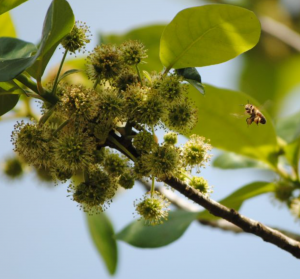
Figure 1. Honeybee visiting tupelo blossoms.
Credit. Gulf County Tourist Development Council.
The tupelo bloom season lasts from approximately mid-April to the end of May. This is an anxious time for beekeepers. Tupelo blooms are very temperamental and delicate in nature. For this short period, beekeepers hope for little wind or rain and no cold temperatures, as any of these factors can decimate tupelo honey production. Regardless of seasonal impacts, the demand for Gulf County’s tupelo honey never subsides.
A bonus to honey’s great taste, is the medicinal value. Honey has been used for medicinal purposes throughout time and cultures. Ancient Egyptians used honey in the embalming process, wound dressing and treatment for burns. Honey can be used as an antimicrobial agent. This is mostly due to low concentrations of hydrogen peroxide produced naturally from sugar compounds. Honey contains large amounts of sugars, approximately 97%. Most of the sugar content is glucose and fructose. Honey also contains smaller amounts of vitamins and minerals.
The color of honey is a factor when grading content. Generally, a darker honey will have a higher concentration of polyphenols. This means the honey is higher in antioxidants and anti-inflammatory properties. Exposure to area honey has been thought to help people who suffer from area specific seasonal allergies. However, there is no consensus among the scientific community to support the claim. Though there is research supporting honey as medicinal purposes, please consult with your physician before using as a medical treatment.
Enjoy tupelo honey and see you at the festival!
For more information on Gulf County Tupelo Honey, please visit:
http://www.tupelohoneyfestival.com/
https://www.visitgulf.com/tupelo-honey
Supporting information for this article can be found in the UF/IFAS EDIS publication “Health Benefits and Medicinal Value of Honey” by Sara Marshall, Liwei Gu and Keith R. Schneider: https://edis.ifas.ufl.edu/pdffiles/FS/FS26700.pdf
An Equal Opportunity Institution. UF/IFAS Extension, University of Florida, Institute of Food and Agricultural Sciences, Nick T. Place, Dean for UF/IFAS Extension. Single copies of UF/IFAS Extension publications (excluding 4-H and youth publications) are available free to Florida residents from county UF/IFAS Extension offices.















